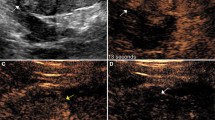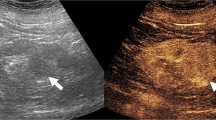Abstract
Contrast-enhanced sonography (CEUS) is a recently introduced, promising technique in the evaluation of the kidney. CEUS allows real-time assessment of normal and abnormal renal perfusions. As a consequence of the macrocirculation analysis allowed by Doppler techniques, it is possible to obtain real-time information about microcirculation. US contrast media are not nephrotoxic and can be employed safely, even in subjects with impaired renal function. There are several clinical scenarios where CEUS may play the role of a low-cost, scarcely invasive tool, including renal tumors (with special reference to small, indeterminate masses, i.e., differentiation between carcinoma and angiomyolipoma), renal atypical cystic masses (i.e., differentiation of malignant from benign cysts and follow-up of cystic lesions managed conservatively), renal infarction, renal infections, and renal injuries. In addition, CEUS can be useful in the assessment of renal pseudotumors (including any case with possible renal mass on conventional US imaging) and has been employed in radiofrequency ablation guidance. This pictorial review illustrates the CEUS findings recognizable in a wide spectrum of renal disorders and discusses the strengths and limitations of renal imaging with CEUS.







Similar content being viewed by others
References
Jakobsen J (1996) Echo-enhancing agents in the renal tract. Clin Radiol 51:S40–43
Jakobsen JA, Correas J-M (2001) Ultrasound contrast agents and their use in urogenital radiology: status and prospects. Eur Radiol 11:2082–2091
Nilsson A (2004) Contrast-enhanced ultrasound of the kidneys. Eur Radiol 14(Suppl 8):104–109
Ascenti G, Zimbaro G, Mazziotti S, Gaeta M, Lamberto S, Scribano E (2001) Contrast-enhanced power Doppler US in the diagnosis of renal pseudotumors. Eur Radiol 11:2496–2499
Atkins MB, Garnick MB (2000) Renal neoplasia. In: Brenner BM, (ed) Brenner and Rector’s the kidney, 6th ed. Philadelphia: WB Saunders, 1044–1068
Yamashita Y, Ueno S, Makita O, Ogata I, Hatanaka Y, Watanabe O, et al. (1993) Hyperechoic renal cell tumors: anechoic rim and intratumoral cysts in US differentiation of renal cell carcinoma from angiomyolipoma. Radiology 188:179–182
Robbin ML, Lockhart ME, Barr RG (2003) Renal imaging with ultrasound contrast: current status. Radiol Clin North Am 41:963–978
Quaia E, Siracusano S, Bertolotto M, Monduzzi M, Pozzi Mucelli R (2003) Characterization of renal tumours with pulse inversion harmonic imaging by intermittent high mechanical index technique: initial results. Eur Radiol 13:1402–1412
Ascenti G, Zimbaro G, Mazziotti S, Gaeta M, Settineri N, Scribano E (2001) Usefulness of power Doppler and contrast-enhanced sonography in the differentiation of hyperechoic renal masses. Abdom Imaging 26:654–660
Ascenti G, Gaeta M, Magno C, Mazziotti S, Blandino A, Melloni D, Zimbaro G (2004) Contrast-enhanced second-harmonic sonography in the detection of pseudocapsule in renal cell carcinoma. AJR 182:1525–1530
Kim AY, Kim SH, Lee IH (1999) Contrast-enhanced power Doppler sonography for the differentiation of cystic renal lesions: preliminary study. J Ultrasound Med 18:581–588
Bosniak MA (1997) The use of the Bosniak classification system for renal cysts and cystic tumors. J Urol 157:1852–1853
Brown JM, Quedens-Case C, Alderman JL, Greener Y, Taylor KJ (1997) Contrast enhanced sonography of visceral perfusion defects in dogs. J Ultrasound Med 16:493–499
Kim JH, Eun HW, Lee HK, Park SJ, Shin JH, Hwang JH, et al. (2003) Renal perfusion abnormality. Coded harmonic angio US with contrast agent. Acta Radiol 44:166–171
Kim B, Kim HK, Choi MH, Woo JY, Ryu J, Kim S, Peck KR (2001) Detection of parenchymal abnormalities in acute pyelonephritis by pulse inversion harmonic imaging with or without microbubble ultrasonographic contrast agent: correlation with computed tomography. J Ultrasound Med 20:5–14
Goldberg BB, Merton DA, Liu J-B, Forsberg F (1998) Evaluation of bleeding sites with a tissue-specific sonographic contrast agent: preliminary experiences in an animal model. J Ultrasound Med 17:609–616
Ogan K, Jacomides L, Dolmatch BL, Rivera FJ, Dellaria MF, Josephs SC, et al. (2002) Percutaneous radiofrequency ablation of renal tumors: technique, limitations, and morbidity. Urology. 60:954–958
Johnson DB, Duchene DA, Taylor GD, Pearle MS, Cadeddu JA (2005) Contrast enhanced ultrasound evaluation of radiofrequency ablation of the kidney: reliable imaging of the thermolesion. J Endiurik 19:248–252
Author information
Authors and Affiliations
Corresponding author
Rights and permissions
About this article
Cite this article
Setola, S.V., Catalano, O., Sandomenico, F. et al. Contrast-enhanced sonography of the kidney. Abdom Imaging 32, 21–28 (2007). https://doi.org/10.1007/s00261-006-9001-7
Published:
Issue Date:
DOI: https://doi.org/10.1007/s00261-006-9001-7




